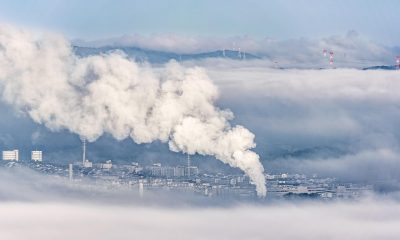Energy
Dangerous or Ingenious? Geoengineering May Hold the Key to Battling Climate Change
Securities.io is not an investment adviser, and this does not constitute investment advice, financial advice, or trading advice. Securities.io does not recommend that any security should be bought, sold, or held by you. Conduct your own due diligence and consult a financial adviser before making any investment decisions.

The term geoengineering might sound audacious at first. How can someone engineer something natural or geological? However, it is not at all about acting against nature's course. It is rather the opposite. Termed often as the ‘climate’s plan B’, it is a way to battle global warming or climate change.
Harvard University’s solar geoengineering research program defines geoengineering as a ‘set of emerging technologies that could manipulate the environment and partially offset some of the impacts of climate change.’
The Harvard University Geoengineering Program sees the domain as a composite of two broad categories: carbon geoengineering or carbon-di-oxide removal (CDR) and solar geoengineering or solar radiation management (SRM).
Some studies have incorporated a third category, weather modification. These categories can have further subcategories. But before delving deeper into them, let us look at what CDR and SRM refer to.
Carbon geoengineering, or carbon dioxide removal, as evident from the name, aims at removing carbon dioxide from the atmosphere. This path sees the accumulation of carbon dioxide in the atmosphere as the root cause of climate change. Carbon dioxide harms the environment by working through the chain of emission from concentration to temperature to impact. And the goal of carbon geoengineering is to break the link from emissions to concentration.
The link from concentration to temperature is what solar geoengineering or solar radiation management aims to break. More precisely, it aims at reflecting a small fraction of sunlight into space. By increasing the amount of solar radiation that goes back to space, this process seeks to cool the planet.
However, both these geoengineering types can be split into multiple subtypes, depending on the location where they’re addressed and the areas it impacts.
Geoengineering Types
Solar radiation management acts through multiple technologies, including stratospheric aerosol injection, surface albedo modification, and microbubbles.
Carbon dioxide removal, on the other hand, can happen through technological interventions like carbon capture and storage, direct air capture, carbon capture use and storage, bioenergy with carbon capture and storage, ocean fertilization, enhanced weathering, and enhanced photosynthesis. Each of these technologies is distinct from one another.
Stratospheric Aerosol Injection
This process aims at spraying large quantities of tiny reflective particles into the stratosphere to cool the planet by reflecting sunlight into space. The proposed range of reflective particles includes sulfur dioxides, finely powdered salt, or calcium carbonate. The spraying could be done from aircraft using artillery guns or large hoses to reach the sky.
According to a study led by Indiana University researchers, scattering sunlight-reflecting particles in the atmosphere could slow rapid melting in West Antarctica and reduce the risk of catastrophic sea-level rise. Paul Goddard, an Indiana University researcher and lead author of the study, explains the potential benefits of this approach. He states:
“Exploring ways to reflect sunlight into space before it is absorbed into Earth’s climate system could help buy us more time to address climate change and avoid or delay climate tipping points, such as the collapse of the West Antarctic Ice Sheet.”
Surface Albedo Modification
This proposed technique of geoengineering aims at reflecting more sunlight into space by enhancing Earth albedo, a measure of how much of the Sun's light is reflected back into space off the Earth’s surface.
It could be done in multiple ways, including growing crops that reflect more light, covering large desert or ice areas with reflective materials, whitening mountaintops and roofs with white paint, and more.
To add more context, a high albedo is when most of the radiation is reflected. Conversely, a low albedo surface refers to dark ocean surfaces that reflect a small share and absorb most of the solar radiation in the form of heat.
Marine Cloud Brightening
The purpose of this technique is to generate or create whiter clouds as a means to reflect more sunlight into space. To achieve this purpose, the proposed technology aims at enhancing the concentration of smaller cloud droplets.
The proponents of this technology recommend shooting large amounts of tiny particles like sea salt aerosols into marine clouds, which would act as cloud condensation nuclei.
For the particles to reach the clouds, the proposal suggests injecting salty aerosols into marine cloud layers by spraying seawater from vessels with nozzles capable of turning saltwater into tiny particles.
Microbubbles
This geoengineering technique proposes injecting microbubbles into water bodies or sea foam to spray them onto the ocean surface. The aim is to reflect more sunlight into the space by altering the albedo of the water surfaces.
A brighter water surface would have higher albedo, resulting in lowered absorption and less transformation of the Sun’s energy into heat. Now, we will look into some of the Carbon dioxide removal techniques.
Carbon Capture and Storage
This process was originally developed by the oil industry and is often called the Enhanced Oil Recovery technique (EDR). It works by pumping pressurized carbon dioxide into oil reservoirs to extract remaining deposits from aging oil fields and recover oil that was inaccessible otherwise.
Direct Air Capture
Another proposed Greenhouse Gas Removal (GGR) technology, Direct Air Capture, could remove carbon dioxide from the planet’s atmosphere on a large scale. The technique plans to leverage chemical reactions to scrub carbon dioxide from the atmosphere with substances that may act as a selective carbon dioxide filter. There are two developed processes: liquid solvents and solid sorbents.
An example of a liquid solvent could be a strong hydroxide solution for carbon dioxide to dissolve in. Otherwise, carbon dioxide might stick to the surface of a solid sorbent, such as plastic resin.
Carbon Capture Use and Storage
This technology proposes the removal of carbon dioxide by capturing the gas from industrial exhaust fumes or directly from the atmosphere. The captured gas is used as a manufacturing feedstock. It stays stored in manufactured goods until released into the atmosphere again.
Click here for the list of best carbon capture stocks to invest in.
Bioenergy with Carbon Capture and Storage
As evident from the name, this proposed technique aims at capturing carbon dioxide from bioenergy applications and storing it through Carbon Capture and Storage or reusing it with carbon capture.
Ocean Fertilization
This theoretical technology suggests dumping large volumes of micro and macro-nutrients into ocean areas where biological productivity is low. The objective is to encourage the growth of phytoplankton that will absorb atmospheric carbon dioxide and store it. Available data points towards at least sixteen open ocean fertilization experiments over the last 30 years.
Enhanced Weathering
The proposed intervention of enhanced weathering seeks to remove carbon dioxide by spreading large chunks of selected and finely ground rock material onto the vast spreads of land areas, beaches, and sea surfaces. The process draws inspiration from silicate and carbonate rocks’ natural weathering process.
The proponents of this theory want to create a slow carbonation process that would slowly consume and absorb nearly one billion tonnes of carbon dioxide from the atmosphere every year.
Enhanced Photosynthesis

Enhanced photosynthesis would serve its purpose by genetically manipulating plants and algae. It would work on crops like rice, wheat, cotton, and trees. The objective is to make these crops metabolize more carbon dioxide on the assumption that these plants could store additional carbon on the ground.
With all these geoengineering interventions ready to be taken up, one has to estimate carefully how beneficial or dangerous they could be in their applications in real life. We will look at some of the more popular techniques and their pros and cons.
The Potential Benefits and Dangers of GeoEngineering
Pros and Cons of Stratospheric Aerosol Injection
This process could prove a remedy to global warming by offsetting the heating up of the planet from a doubling of carbon dioxide. Since it works on the model of how big volcanic eruptions cool the planet, it is a known process. It is also affordable and feasible.
The expected disadvantages could be a reduction in rainfall or an altering of regional climates, resulting in natural hazards. This process would not stop ocean acidification, and the stopping of the process might result in planets warming rapidly if carbon dioxide levels continue to rise.
Pros and Cons of Marine Cloud Brightening
The primary advantage of marine cloud brightening is offsetting all the warming from a doubling of carbon dioxide. Another significant advantage of this process could be the possibility of cooling the poles more than the tropics, slowing or stopping ice loss. The process does not require toxic chemicals and is affordable and feasible.
However, one has to remember that marine cloud brightening is still very much at a theoretical stage, without any real-world tests being done and necessary technologies being mostly unavailable. The process might reduce rainfall and alter regional climates with effects as disastrous as the drying of the Amazon.
Pros and Cons of Enhanced Photosynthesis
The plan is to turn plants into biochar and make them absorb the carbon to eventually end up being mixed into the soil. One of the biggest advantages of this process is that it is safe and aims at slowing climate change rather than attempting to drastically reverse it. Unlike many other geoengineering technologies, enhanced photosynthesis has the power to slow the rate of ocean acidification.
However, enhanced photosynthesis efficacy is yet to be established. Many experts are of the opinion that it could offset a maximum of 10 percent of the warming due to a doubling of carbon dioxide. The process is also deemed incapable of preventing large sea-level rises.
The Pros and Cons of Ocean Fertilization
Ocean fertilization is safe and seeks to slow the rate of change rather than drastically changing the course. It is capable of slowing the rate of ocean acidification as well.
However, scientists believe that its efficacy could be highly limited and only offset a mere 5 percent of the warming resulting from a doubling of carbon dioxide. Applying this process may also end in causing or accelerating ocean deoxygenation and damaging marine ecosystems.
While many of the Geoengineering techniques are theoretical and await real-life application, there are some enterprises that have started with it in some capacity.
Companies Working on GeoEngineering Applications
1. Make Sunsets
Make Sunsets primarily works with the technique of Stratospheric Aerosol Injections. According to the data made public by the company, it has launched 28 balloons and offset 4,791 ton-years of warming. The company believes that SAI is an immediate and necessary solution to cool the planet and can buy time for humankind to transition to a more sustainable future.
Make Sunsets positions itself as a sunlight reflection company that creates biodegradable reflective clouds at high altitudes to cool the planet. It has its headquarters in Box Elder, South Dakota, United States. The firm raised a pre-seed funding of US$750,000 from Boost VC and Pioneer Fund in December 2022.
GeoEngineering: Dangerous or Ingenious
Climate change is a reality, and there is a pressing need to address these concerns through scientific and technological means as fast as possible. Whether GeoEngineering could be the answer is for the future to decide. It is still at its early stage of implementation, and many of the techniques are limited to theoretical conceptualizations only.
On the positive side, the implementation of SAI has been found to be relatively inexpensive compared to other large-scale climate mitigation strategies. If not a full-fledged remedy in itself, it can work as a supplement to other strategies, serving as a temporary measure while long-term efforts to reduce greenhouse gas emissions are being developed and deployed.
But all these have to be done with caution. It has to be ensured that there is no damaging or unintended consequence, like ozone depletion or rapid rebound, when the process is stopped.
More scientific and technological research has to be done to ascertain the viability of geoengineering. But it certainly opens up and expands the horizon of scientific thinking to acquire more ideas on how climate change could be battled effectively.











